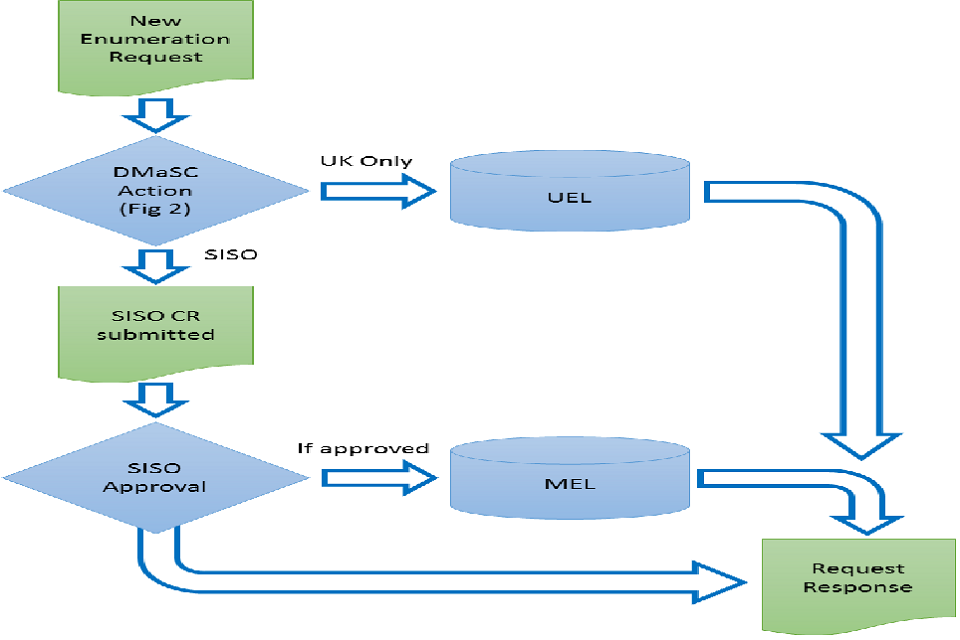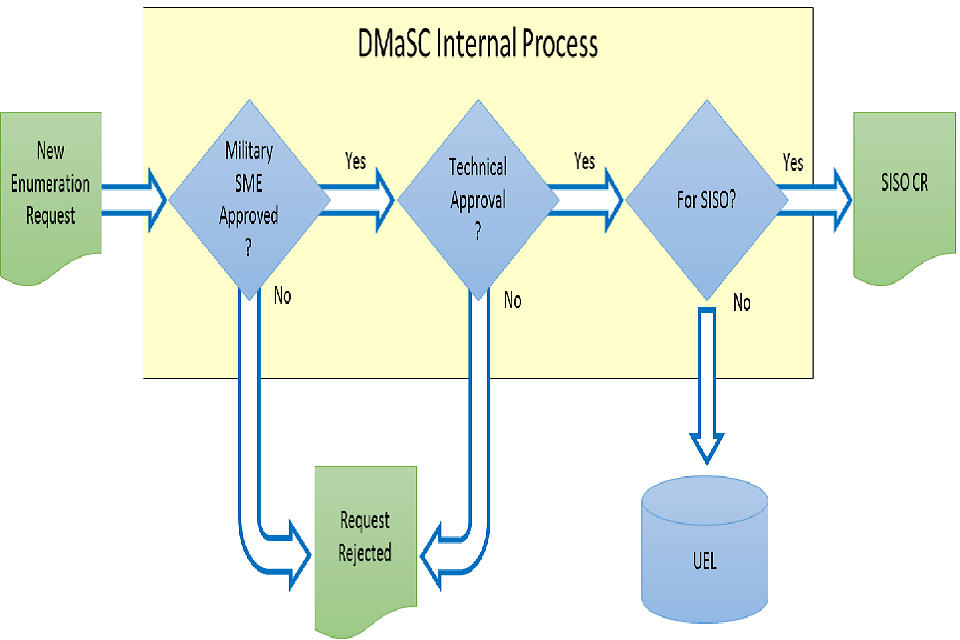Policy for UK enumerations for distributed simulation
Updated 5 May 2021
Version history
| Version | Date Issued | Comments |
|---|---|---|
| 0.1 | 22 Mar 13 | Initial draft for review |
| 1.0 | 14 Jun 13 | First version |
| 2.0 | 3 Jan 18 | Revised to reflect move to DMaSC and policy review |
| 3.0 | 9 Mar 2021 | Revised to add clarity and simplification |
Introduction
With the use of distributed simulation, a requirement exists to be able to identify individual entities across linked simulations in a co-ordinated manner. This to ensure that the same 3D models are seen in each linked simulation at any given time.
This requirement is satisfied by a numerical identifier for each possible 3D model known as an Enumeration. These enumerations are managed via co-ordinated lists of numerical values and descriptions.
As this requirement has grown and become more widespread across international borders, a co-ordinated international Master Enumerations List (MEL) (also known as SISO-REF-101) for distributed simulations, and responsibility for its management, was placed under the auspices of the Simulation Interoperability Standards Organisation (SISO).
Originally designed for the Distributed Interoperability Standard (DIS), enumerations are now also used by the High Level Architecture (HLA), Test and Training Enabling Architecture (TENA) and other interoperability standards.
International enumerations management
There is a SISO Special Working Group (SWG) (known as SWG Enumerations) that publishes, maintains, supports, and updates the international SISO Reference Product, SISO-REF-010; Enumerations for Simulation Interoperability. This reference product is recognised by NATO and the wider M&S community as the definitive international coordinated enumerations reference document.
The latest version of SISO-REF-010 and its associated Operations Manual (OPMAN) (SISO-REF-010.1) are available on the Simulation Interoperability Standards Organization website.
UK enumerations management
The DSC Front Door, with support from DMaSC Technical Authority (TA), is responsible for:
a. The management of all UK enumerations on behalf of the MOD in the form of a UK Enumerations List (UEL); and
b. UK submissions to the SISO SWG Enumerations for inclusion into SISO-REF-010.
Scope
The UEL is to be a subset, and possibly a superset (to allow for different classifications of data and other reasons), of the unclassified MEL as managed by SISO.
The UEL will be broken down into parts, each to cover a separate classification level.
The content of the UEL will consist of:
a. UK operated equipment (where different from other nations);
b. Project specific requests; and
c. Non-procured and research equipment.
New enumeration process
The starting point for all new enumerations requests is the DSC Front Door.
The DSC Front Door will create and issue a temporary entry in the UEL in the knowledge of a likely solution provided by the SISO SWG Enumerations; to whom a formal enumeration will be requested by the DSC Front Door via a formal Change Request (CR) for subsequent integration into the MEL.
If the required enumerations are outside of SISO applicability, for example for anything above unclassified or to satisfy a local requirement, then a local process will be followed. These enumerations will be held in a separate part of the UEL and distributed by the DSC to inform UK programmes as required.
Requests for enumerations will be assessed by the approvals process shown in Figure 1. If the request is suitable, it will be forwarded as a CR to SISO for incorporation into the SISO-REF-010. Otherwise it will be held separately in the UEL.

An infographic showing the workflow from a new renumeration request to its approval and the request response
The DMaSC Enumerations internal process, as shown in Figure 2, is managed by the DSC Front Door and overseen by the DMaSC TA. The Military SME Approval is to ascertain that the enumeration(s) requested reflect the military capability that is being represented. The Technical Approval stage is undertaken by the DSC FD based on the recommendations of the previous stages.

An infographic showing the DMaSC internal process from a new renumeration request to completion.
At all stages, the status of the request will be available in an online spreadsheet. Once the approval has been granted or refused, the requestor will be informed by email of the outcome of their request, and any new enumerations allocated. Requests that go forward to SISO will be formatted into the SISO change request process by the DSC FD and placed into their review process. The outcome of the SISO review will be communicated back to the requestor. Whilst undergoing SISO review the enumeration will be held in the UEL but removed once and if approved by SISO.
SISO approval process
The SISO Enumerations Approval Process is detailed within the Reference for Standards Activities Committee Special Working Group Enumerations for Simulation Operations Manual that can be found on the Simulation Interoperability Standards Organization website.
Submitting a request for a new amendment
Any requests for a new enumeration should be submitted to the DSC Front Door in an Excel document with columns populated as shown below in Figure 3.
Figure 3 - Example Enumerations
| Kind | Domain | Country | Category | Sub-category | Specific | Extra | |
|---|---|---|---|---|---|---|---|
| 1 | 2 | 224 | 50 | UAVs | |||
| 1 | 2 | 224 | 50 | 1 | HERTI UAV | ||
| 1 | 2 | 224 | 50 | 1 | 1 | HERTI 1-D UAV | |
| 1 | 2 | 224 | 50 | 1 | 2 | HERTI 1-A UAV | |
| 1 | 2 | 224 | 50 | 2 | Watchkeeper WK450 (variation of 1.2 105.50.1) | ||
| 1 | 2 | 224 | 50 | 3 | Blackstart UAV |
Each column in the table is defined as follows:
a. Kind: Platform, munition, life form, environmental, cultural, etc.
b. Domain: Land, air, surface, sub-surface, space, etc.
c. Country: Where from (e.g. 224 = UK, 225 = US).
d. Category: Type, within specific Domain (e.g. for Land: 01=Tank, 02=APC, etc).
e. Sub-category: Used to further refine Category details (e.g. a Challenger Tank).
f. Specific: Actual type/mark of entity (e.g. a Challenger 2).
g. Extra: Other refinement if needed (less commonly used). Note: not to be used for appearance purposes, e.g. types of camouflage.
